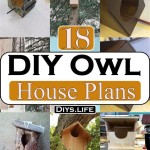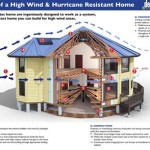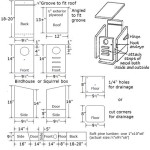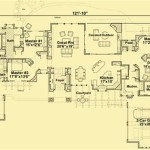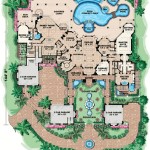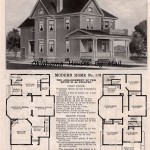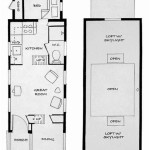A Mid Century Modern House Plan is a blueprint or design for a house that embodies the architectural style popular from the 1930s to the 1960s. These plans prioritize functionality, simplicity, and a connection to the outdoors, emphasizing clean lines, open floor plans, and large windows. An example of a Mid Century Modern House Plan can be seen in the iconic Case Study House No. 22 by architect Pierre Koenig, a steel-and-glass masterpiece that blurs the boundaries between interior and exterior spaces.
Mid Century Modern House Plans have become increasingly popular in recent years due to their timeless aesthetic and emphasis on indoor-outdoor living. They often feature large, open living areas that flow seamlessly into outdoor patios or decks, creating a sense of spaciousness and connection to nature. The plans also incorporate energy-efficient features, such as passive solar design and cross-ventilation, making them both stylish and environmentally friendly.
In the following sections, we will explore the key characteristics of Mid Century Modern House Plans, discuss their benefits and challenges, and provide tips for designing and building your own Mid Century Modern dream home.
Mid Century Modern House Plans are characterized by the following key points:
- Clean lines
- Open floor plans
- Large windows
- Indoor-outdoor connection
- Passive solar design
- Cross-ventilation
- Natural materials
- Flat roofs
- Geometric shapes
- Asymmetrical facades
These elements combine to create homes that are both stylish and functional, with a strong emphasis on natural light and connection to the outdoors.
Clean lines
Clean lines are one of the defining characteristics of Mid Century Modern House Plans. This refers to the use of straight lines and simple forms throughout the design of the home, both inside and out. Clean lines create a sense of order and simplicity, and they help to emphasize the home’s connection to the outdoors.
- Horizontal lines: Horizontal lines are often used to create a sense of length and openness in Mid Century Modern homes. These lines can be seen in the long, low profiles of the homes, as well as in the use of horizontal bands of windows and other elements.
- Vertical lines: Vertical lines are also used to create a sense of height and drama in Mid Century Modern homes. These lines can be seen in the tall, narrow windows and doors, as well as in the use of vertical siding and other elements.
- Geometric shapes: Geometric shapes are another key element of Mid Century Modern design. These shapes can be seen in the use of squares, rectangles, and circles throughout the home, both inside and out. Geometric shapes create a sense of order and simplicity, and they help to emphasize the home’s connection to the modern art movement.
- Asymmetrical facades: Asymmetrical facades are also common in Mid Century Modern homes. This refers to the use of different shapes and sizes on different sides of the home. Asymmetrical facades create a sense of visual interest and dynamism, and they help to break up the monotony of a symmetrical design.
Overall, the use of clean lines in Mid Century Modern House Plans creates a sense of order, simplicity, and connection to the outdoors. These homes are both stylish and functional, and they continue to be popular today.
Open floor plans
Open floor plans are another defining characteristic of Mid Century Modern House Plans. This refers to the use of large, open spaces that flow seamlessly from one room to another. Open floor plans create a sense of spaciousness and openness, and they allow for a more flexible use of space.
There are many benefits to using an open floor plan in a Mid Century Modern home. First, open floor plans allow for a more efficient use of space. By eliminating walls and other barriers, open floor plans create a more spacious and airy feeling, even in small homes. Second, open floor plans promote a more social and interactive lifestyle. By removing the barriers between different rooms, open floor plans encourage family members and guests to interact with each other more easily. Third, open floor plans are more flexible and adaptable than traditional floor plans. By eliminating walls, open floor plans allow for a more flexible use of space, which can be easily reconfigured to meet the changing needs of a family.
There are also some challenges to consider when using an open floor plan in a Mid Century Modern home. First, open floor plans can be more difficult to heat and cool than traditional floor plans. This is because the lack of walls and other barriers allows heat and cold air to circulate more easily throughout the home. Second, open floor plans can be more noisy than traditional floor plans. This is because sound can travel more easily throughout an open space. Third, open floor plans can be less private than traditional floor plans. This is because there are fewer walls and other barriers to block out noise and activity from other rooms.
Overall, open floor plans are a popular feature of Mid Century Modern House Plans. They create a sense of spaciousness, openness, and flexibility. However, there are also some challenges to consider when using an open floor plan in a Mid Century Modern home.
Large windows
Large windows are another defining characteristic of Mid Century Modern House Plans. These windows allow for a greater connection to the outdoors and help to create a sense of spaciousness and openness. They are often placed along the entire length of a wall, or even around corners, to maximize the amount of natural light that enters the home.
There are many benefits to using large windows in a Mid Century Modern home. First, large windows allow for a greater connection to the outdoors. By bringing the outside in, large windows help to create a more relaxing and inviting atmosphere. Second, large windows help to create a sense of spaciousness and openness. By allowing more natural light to enter the home, large windows make rooms feel larger and more airy. Third, large windows can help to reduce energy costs. By allowing natural light to heat the home during the day, large windows can help to reduce the need for artificial lighting and heating.
There are also some challenges to consider when using large windows in a Mid Century Modern home. First, large windows can be more expensive to install and maintain than smaller windows. Second, large windows can allow for heat gain in the summer and heat loss in the winter, which can increase energy costs. Third, large windows can be less private than smaller windows, as they allow people to see into the home from the outside.
Overall, large windows are a popular feature of Mid Century Modern House Plans. They create a sense of spaciousness, openness, and connection to the outdoors. However, there are also some challenges to consider when using large windows in a Mid Century Modern home.
Indoor-outdoor connection
The indoor-outdoor connection is a key element of Mid Century Modern House Plans. This refers to the use of design elements that blur the lines between the interior and exterior of the home, creating a seamless flow between the two spaces.
- Large windows and doors: Large windows and doors are a common feature of Mid Century Modern homes. These openings allow for a greater connection to the outdoors and help to create a sense of spaciousness and openness. They often lead out to patios, decks, or other outdoor living areas, further blurring the lines between the interior and exterior of the home.
- Open floor plans: Open floor plans are another key element of Mid Century Modern homes. These plans create a more fluid and interconnected space, allowing for easy movement between different areas of the home. Open floor plans often incorporate large windows and doors, further enhancing the connection to the outdoors.
- Indoor-outdoor living areas: Many Mid Century Modern homes feature indoor-outdoor living areas, such as patios, decks, or courtyards. These areas are designed to seamlessly blend the interior and exterior of the home, creating a more versatile and enjoyable living space.
- Natural materials: Mid Century Modern homes often use natural materials, such as wood, stone, and glass, which help to create a more organic and inviting connection to the outdoors. These materials bring the beauty of nature into the home, creating a more relaxing and harmonious living environment.
Overall, the indoor-outdoor connection is a key element of Mid Century Modern House Plans. This connection creates a more spacious, open, and inviting living space, while also blurring the lines between the interior and exterior of the home.
Passive solar design
Passive solar design is a key element of Mid Century Modern House Plans. It refers to the use of design elements that allow a home to heat and cool itself naturally, reducing the need for artificial heating and cooling systems.
There are many benefits to using passive solar design in a Mid Century Modern home. First, passive solar design can help to reduce energy costs. By allowing the home to heat and cool itself naturally, passive solar design can reduce the need for artificial heating and cooling systems, which can save money on energy bills. Second, passive solar design can help to improve the home’s comfort level. By providing a more even distribution of heat and light throughout the home, passive solar design can help to create a more comfortable and inviting living environment. Third, passive solar design can help to reduce the home’s environmental impact. By reducing the need for artificial heating and cooling systems, passive solar design can help to reduce greenhouse gas emissions and other pollutants.
There are many different passive solar design strategies that can be used in a Mid Century Modern home. Some of the most common strategies include:
- Orienting the home to the sun: The orientation of the home to the sun is one of the most important factors in passive solar design. In the Northern Hemisphere, homes should be oriented so that the majority of the windows face south. This allows the home to take advantage of the sun’s heat during the winter months.
- Using thermal mass: Thermal mass is a material that can absorb and store heat. By using thermal mass in the home, such as concrete or brick, the home can store heat from the sun during the day and release it at night, helping to keep the home warm.
- Using natural ventilation: Natural ventilation is the use of natural forces to move air through a home. By using natural ventilation, such as opening windows and doors, the home can be cooled during the summer months.
Passive solar design is a key element of Mid Century Modern House Plans. By using passive solar design strategies, homeowners can reduce energy costs, improve the home’s comfort level, and reduce the home’s environmental impact.
Cross-ventilation
Cross-ventilation is the use of natural forces to move air through a home, creating a more comfortable and healthy living environment. In a Mid Century Modern House Plan, cross-ventilation is often achieved through the use of large windows and doors that are placed on opposite sides of the home. This allows air to flow freely through the home, even when the windows and doors are closed.
There are many benefits to using cross-ventilation in a Mid Century Modern home. First, cross-ventilation can help to reduce energy costs. By allowing air to flow naturally through the home, cross-ventilation can reduce the need for artificial heating and cooling systems, which can save money on energy bills. Second, cross-ventilation can help to improve the home’s comfort level. By providing a more even distribution of heat and light throughout the home, cross-ventilation can help to create a more comfortable and inviting living environment. Third, cross-ventilation can help to reduce the home’s environmental impact. By reducing the need for artificial heating and cooling systems, cross-ventilation can help to reduce greenhouse gas emissions and other pollutants.
There are many different ways to incorporate cross-ventilation into a Mid Century Modern House Plan. Some of the most common strategies include:
- Placing windows and doors on opposite sides of the home: This is the most effective way to create cross-ventilation in a home. By placing windows and doors on opposite sides of the home, air can flow freely through the home, even when the windows and doors are closed.
- Using clerestory windows: Clerestory windows are windows that are placed high on a wall, near the ceiling. These windows allow air to flow into the home from above, which can help to create a more even distribution of air throughout the home.
- Using transom windows: Transom windows are windows that are placed above a door. These windows allow air to flow into the home from above the door, which can help to create a more comfortable and inviting entryway.
Cross-ventilation is a key element of Mid Century Modern House Plans. By using cross-ventilation strategies, homeowners can reduce energy costs, improve the home’s comfort level, and reduce the home’s environmental impact.
Natural materials
Natural materials are an important part of Mid Century Modern House Plans. These materials help to create a warm and inviting atmosphere, and they can also help to reduce the home’s environmental impact.
- Wood: Wood is a versatile material that can be used for a variety of purposes in a Mid Century Modern home. It can be used for flooring, walls, ceilings, and even furniture. Wood is a durable material that is easy to maintain, and it can add a touch of warmth and elegance to any home.
- Stone: Stone is another popular natural material that is often used in Mid Century Modern homes. It can be used for flooring, walls, countertops, and even fireplaces. Stone is a durable material that is easy to clean, and it can add a touch of luxury to any home.
- Glass: Glass is a versatile material that can be used for a variety of purposes in a Mid Century Modern home. It can be used for windows, doors, walls, and even furniture. Glass is a transparent material that allows light to flow freely through the home, and it can help to create a more open and spacious feel.
- Concrete: Concrete is a durable and versatile material that is often used in Mid Century Modern homes. It can be used for flooring, walls, ceilings, and even furniture. Concrete is a low-maintenance material that is easy to clean, and it can add a touch of industrial chic to any home.
Natural materials are an important part of Mid Century Modern House Plans. These materials can help to create a warm and inviting atmosphere, and they can also help to reduce the home’s environmental impact.
Flat roofs
Flat roofs are a defining characteristic of Mid Century Modern House Plans. They give homes a clean and modern look, and they can also help to reduce energy costs.
- Increased usable space: Flat roofs provide additional usable space that can be used for patios, gardens, or other outdoor living areas. This is especially beneficial in urban areas where outdoor space is limited.
- Energy efficiency: Flat roofs can be more energy efficient than sloped roofs. This is because flat roofs have a smaller surface area, which reduces heat loss and gain. Additionally, flat roofs can be easily fitted with solar panels, which can generate electricity and further reduce energy costs.
- Low maintenance: Flat roofs are easier to maintain than sloped roofs. This is because flat roofs do not have to be cleaned or repaired as often. Additionally, flat roofs are less likely to leak than sloped roofs.
- Modern aesthetic: Flat roofs give homes a clean and modern look. This aesthetic is popular in both residential and commercial buildings.
Flat roofs are a popular choice for Mid Century Modern homes. They offer a number of benefits, including increased usable space, energy efficiency, low maintenance, and a modern aesthetic.
Geometric shapes
Geometric shapes are a key element of Mid Century Modern House Plans. These shapes create a sense of order and simplicity, and they help to emphasize the home’s connection to the modern art movement.
- Squares: Squares are one of the most common geometric shapes used in Mid Century Modern House Plans. They are often used to create a sense of order and symmetry. Squares can be used for windows, doors, walls, and even roofs.
- Rectangles: Rectangles are another common geometric shape used in Mid Century Modern House Plans. They are often used to create a sense of length and openness. Rectangles can be used for windows, doors, walls, and even floor plans.
- Circles: Circles are a less common geometric shape used in Mid Century Modern House Plans, but they can be very effective when used correctly. Circles can be used to create a sense of movement and fluidity. Circles can be used for windows, doors, and even fireplaces.
- Triangles: Triangles are another less common geometric shape used in Mid Century Modern House Plans, but they can be very effective when used correctly. Triangles can be used to create a sense of drama and excitement. Triangles can be used for windows, doors, and even roofs.
Geometric shapes are a powerful tool that can be used to create a variety of different effects in Mid Century Modern House Plans. By using geometric shapes in a creative and thoughtful way, architects can create homes that are both stylish and functional.
Asymmetrical facades
Asymmetrical facades are a common feature of Mid Century Modern House Plans. This refers to the use of different shapes and sizes on different sides of the home. Asymmetrical facades create a sense of visual interest and dynamism, and they help to break up the monotony of a symmetrical design.
There are many different ways to create an asymmetrical facade. One common approach is to use different window sizes and shapes on different sides of the home. For example, a home might have large windows on one side and smaller windows on the other side. Another approach is to use different rooflines on different sides of the home. For example, a home might have a flat roof on one side and a sloped roof on the other side.
Asymmetrical facades can be used to create a variety of different effects. For example, an asymmetrical facade can be used to create a sense of movement and energy. It can also be used to create a sense of drama and excitement. Additionally, an asymmetrical facade can be used to create a sense of privacy. For example, a home with an asymmetrical facade might have a large window on one side of the home and a smaller window on the other side. This would allow the homeowner to have a large window for natural light and views, while also maintaining privacy on the other side of the home.
Asymmetrical facades are a popular choice for Mid Century Modern homes. They offer a number of benefits, including visual interest, dynamism, and privacy. By using asymmetrical facades in a creative and thoughtful way, architects can create homes that are both stylish and functional.










Related Posts

